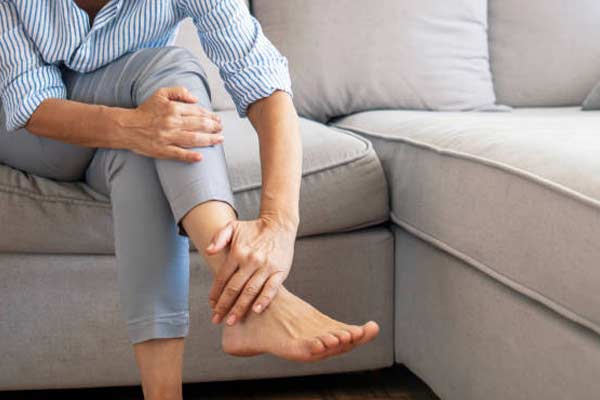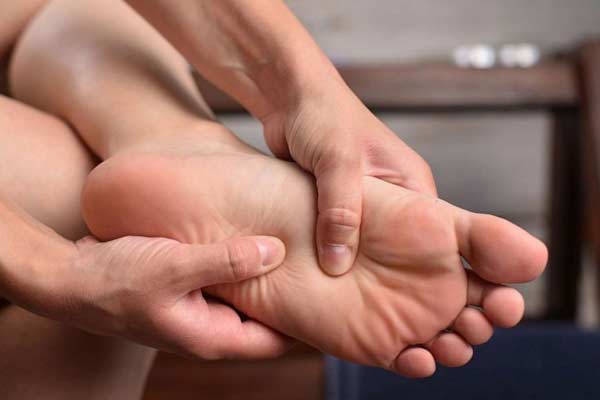Fibromyalgia is a persistent disorder marked by widespread musculoskeletal pain, fatigue, and sleep disturbances. While commonly linked to muscle and joint pain, this condition can also induce foot discomfort.
Research suggests that approximately 50% of people with fibromyalgia experience pain in one or both feet. However, foot pain is not one of the most common symptoms of fibromyalgia.
A study in Arthritis Research & Therapy revealed that neck pain affects 91% of individuals with fibromyalgia, while 79% experience hip pain.
Although the precise cause of foot pain in fibromyalgia remains unclear, researchers suggest that the condition intensifies pain sensations by influencing the processing of signals in the brain and spinal cord, impacting both painful and non-painful signals.
This amplification of pain signals may cause people with fibromyalgia to experience foot pain, even when there is no visible injury or inflammation.

Fibromyalgia and Foot Pain
Fibromyalgia, a persistent condition, leads to widespread pain and tenderness throughout the body.
Although the precise cause remains elusive, researchers posit a connection to irregular levels of specific brain chemicals and alterations in how the nervous system interprets pain signals. Foot pain stands out as a prevalent symptom of fibromyalgia.
People with fibromyalgia often experience foot pain that can range from mild to severe. The pain may be burning, aching, or tingling and may be accompanied by numbness or sensitivity to pain. Walking or standing for long periods can exacerbate the pain.
Emerging studies show a growing correlation between fibromyalgia and foot pain, especially among women. Some researchers believe that biomechanical irregularities can exacerbate foot pain caused by fibromyalgia.
In addition to foot pain, people with fibromyalgia may also experience other musculoskeletal symptoms, such as stiffness and fatigue.
Effectively managing fibromyalgia foot pain requires a balanced approach involving medications and lifestyle adjustments.
Your healthcare provider might advise using anti-inflammatory drugs, both over-the-counter and prescription pain relievers, antidepressants, muscle relaxants, sleep aids, and anti-seizure medications to better control pain and promote improved sleep.
Additionally, selecting comfortable shoes with proper arch support and cushioning can significantly ease foot discomfort.

Causes of Foot Pain in Fibromyalgia
Fibromyalgia presents with widespread musculoskeletal pain, symptoms such as fatigue, sleep disturbances, and issues with memory and mood.
Although the precise cause of fibromyalgia remains unknown, researchers posit that it intensifies the experience of pain by influencing how the brain and spinal cord process signals, whether painful or non-painful.
Numerous studies indicate that individuals with fibromyalgia often experience more foot pain than those without the condition.
It’s worth noting that not everyone with fibromyalgia necessarily encounters foot pain. However, for those who do, it can pose challenges in activities such as walking, standing, or engaging in exercise. The origins of foot pain in fibromyalgia can be diverse and may encompass:
- Inflammation: Inflammation in the joints and fascia can cause foot pain in people with fibromyalgia. Fibromyalgia can cause inflammation, leading to joint pain and stiffness, including in the feet.
- Plantar fasciitis: The irritation of a stretchy band of tissue across the sole leads to plantar fasciitis. This foot condition often accompanies fibromyalgia and is a frequent source of pain for those with this disorder.
- Fascia: Fascia is a connective tissue surrounding muscles, bones, and joints. In people with fibromyalgia, the fascia can become tight and painful, leading to foot pain.
- Joints: Fibromyalgia can cause joint pain and stiffness, leading to foot pain. The small joints in the feet can be particularly affected.
- Nervous system: Fibromyalgia can affect the nervous system, leading to foot pain and sensitivity. This can cause foot pain, even without any physical damage or injury.
- Myofascial pain syndrome: Myofascial pain syndrome results in the development of trigger points, often called muscle knots. These points are responsible for inducing pain that can be felt in different parts of the body, including the feet.
- Referred pain: Referred pain is felt in one part of the body but caused by a problem in another. In people with fibromyalgia, referred pain can cause foot pain even if there is no injury or damage to the feet.
- High arches can cause foot pain, particularly in people with fibromyalgia. High arches can put extra pressure on the feet, leading to pain and discomfort.

Diagnosing Fibromyalgia and Foot Pain
Diagnosing fibromyalgia poses a challenge since there isn’t a specific test available. Instead, doctors rely on a combination of the patient’s medical history and a physical examination. This involves ruling out other conditions that share similar symptoms.
Healthcare providers assess widespread pain throughout the body, including the feet, lasting at least three months. They also check for tender points—specific areas on the body that become painful under pressure.
Beyond pain, individuals with fibromyalgia may encounter additional symptoms like fatigue, sleep disturbances, headaches, and cognitive difficulties. When fibromyalgia is suspected, healthcare providers may conduct blood tests to exclude other conditions such as rheumatoid arthritis, lupus, or thyroid issues.
While foot pain is a common fibromyalgia symptom, it can be attributed to other conditions like plantar fasciitis, arthritis, or neuropathy. Therefore, it’s crucial to rule out these conditions before connecting foot pain to fibromyalgia.
Doctors may examine the feet physically, perform X-rays, or order nerve conduction studies to identify the root cause of foot pain.
Determining the most effective treatments for foot pain in fibromyalgia patients might involve experimentation. Possible treatments include medications like pain relievers, antidepressants, or anticonvulsants. Additionally, physical therapy, massage, or acupuncture may be beneficial in managing foot pain.
Treatment Options for Fibromyalgia and Foot Pain
Managing fibromyalgia, which induces widespread pain, including in the feet, involves considering various treatment options to alleviate symptoms.
Medication
Reducing FM pain can involve the use of medication. Over-the-counter options like aspirin, ibuprofen, and naproxen sodium can effectively ease foot pain. It’s crucial to consult with a doctor before considering any medication.
A healthcare professional may also suggest prescription pain relievers, antidepressants, muscle relaxants, sleep aids, or anti-seizure medications based on individual needs.
Physical Therapy
Improving muscle strength and flexibility through physical therapy can alleviate fibromyalgia pain. A personalized exercise program designed by a physical therapist targets muscle stretching and strengthening, particularly in the feet.
Yoga
Gentle yet effective, yoga is an exercise form that alleviates fibromyalgia pain. Additionally, it enhances flexibility, strength, and balance. Consistent yoga practice not only diminishes foot pain but also promotes overall well-being.
Massage
Reducing fibromyalgia pain and enhancing circulation are among the benefits of massage therapy. Skilled massage therapists employ various techniques to address specific areas of foot discomfort.
Stretching
Stretching is an essential part of managing fibromyalgia pain. Stretching the muscles in the feet can help improve flexibility and reduce pain. A physical therapist can develop a stretching program tailored to the individual’s needs.
Pain Relievers
Alleviating foot pain can be achieved with pain relievers like NSAIDs (ibuprofen, Advil, naproxen, Aleve). Nevertheless, extended usage of these medications may lead to adverse effects. Therefore, consulting with a doctor before using any pain relievers is crucial.
Antidepressants
Duloxetine (Cymbalta) and milnacipran (Savella) are antidepressants that can effectively alleviate fibromyalgia pain by boosting specific neurotransmitter levels in the brain. Another prescribed option for managing fibromyalgia pain is Pregabalin (Lyrica).

Lifestyle Adjustments and Home Remedies
While there is no cure for fibromyalgia, lifestyle adjustments and home remedies can help alleviate the symptoms, including foot pain. Here are some tips that may be helpful:
Footwear
Proper footwear is vital in managing foot pain for individuals with fibromyalgia. Choosing shoes with excellent arch support and cushioning is essential to alleviate foot pressure and enhance overall comfort. Additionally, custom-made shoe inserts, known as orthotics, can provide extra support and cushioning for added relief.
Socks
Opting for socks crafted from natural materials like cotton or wool is beneficial for maintaining dry and comfortable feet while minimizing irritation. Incorporating compression socks into your routine can enhance blood circulation and alleviate swelling.
Epsom Salt
When you soak your feet in warm water with Epsom salt, it can help bring down swelling and ease pain. Epsom salt has magnesium, which is good for relaxing muscles and reducing pain.
Relaxation Techniques
Stress and anxiety can exacerbate fibromyalgia symptoms, including foot pain. Relaxation techniques like meditation, deep breathing, and yoga can help reduce stress and promote relaxation.
Tai Chi
Engaging in Tai Chi entails performing slow, graceful movements, and studies have demonstrated its effectiveness in alleviating pain and enhancing physical function for individuals with fibromyalgia.
Slippers
Wearing comfortable and supportive slippers at home can help reduce pressure on the feet and provide more comfort.
Hot Water and Cooling Lotion
Alternating between hot and cold water can help reduce inflammation and relieve pain. Applying a cooling lotion, such as menthol or peppermint, can also help reduce pain and provide a cooling sensation.
Fibromyalgia, Foot Pain, and Gender Differences
Foot pain is a common complaint among people with fibromyalgia and can be debilitating. Walking, standing, and even wearing shoes can be painful.
Foot pain in fibromyalgia is not entirely understood, but researchers think it’s connected to how the brain and spinal cord handle pain signals.
Individuals with fibromyalgia might experience abnormal processing of pain perception, making them more sensitive to pain than those without the condition.
There are also gender differences in the prevalence of fibromyalgia and foot pain. Women are more likely to be diagnosed with fibromyalgia than men.
According to a study, in a sample of Veterans with pain diagnoses, those with fibromyalgia were far more likely to be women. Women diagnosed with fibromyalgia were younger and more likely to have headaches, connective tissue diseases, and psychiatric comorbidities.
Men diagnosed with fibromyalgia exhibited a greater number of concurrent medical conditions. Additionally, the research revealed that women, compared to men, displayed a notably higher Body Mass Index (BMI) and experienced more widespread pain.
These observations point towards potential gender variations in the manifestation and diagnosis of fibromyalgia.
Other Conditions Related to Fibromyalgia and Foot Pain
Fibromyalgia, an intricate condition, may lead to diverse symptoms, including foot pain. Numerous other conditions can also be associated with both fibromyalgia and foot pain. Here are some of the most common:
Arthritis
Arthritis, characterized by joint inflammation resulting in pain, stiffness, and swelling, encompasses various types. Among them, osteoarthritis and rheumatoid arthritis stand out as prevalent. These conditions affect the feet and can induce pain in other body areas.
Lupus
Lupus, an autoimmune disease, presents a range of symptoms, such as joint pain, swelling, fatigue, and skin rashes. Foot pain is prevalent among these symptoms, often from inflammation in the foot’s joints or soft tissues.
Back, Neck, and Leg Pain
Pain from fibromyalgia can affect various body parts, such as the back, neck, and legs. It may manifest as a burning or shooting sensation and can be brought on by stress or physical activity.
Stress
Experiencing stress can notably affect fibromyalgia symptoms, mainly contributing to foot pain. When individuals with fibromyalgia are stressed, their muscles tend to tense up, resulting in discomfort and pain in the feet.
Arms and Shoulders
Fibromyalgia doesn’t just affect your feet; it can also bring about discomfort and rigidity in your arms and shoulders. This discomfort may arise from inflammation in the shoulder’s soft tissues or muscle tension.
Gastrointestinal Issues
Fibromyalgia can cause gastrointestinal issues, including gas, bloating, and constipation. While these symptoms may not seem related to foot pain, they can be caused by inflammation in the gut, which can trigger inflammation in other parts of the body, including the feet.
Medications and Surgery
Certain medications and surgeries can also cause foot pain in people with fibromyalgia. For example, some medications for treating fibromyalgia can cause side effects, including foot pain.
Additionally, surgery on the feet or legs can cause pain and discomfort that may be more severe in people with fibromyalgia.

 Melinda Miles is a courageous fibromyalgia warrior living with the condition for over 10 years. She is an advocate and voice in the fibromyalgia community, having created an online blog, TheFibrowarriors.com, to provide education, support, and community for those affected by this often misunderstood condition.
Melinda Miles is a courageous fibromyalgia warrior living with the condition for over 10 years. She is an advocate and voice in the fibromyalgia community, having created an online blog, TheFibrowarriors.com, to provide education, support, and community for those affected by this often misunderstood condition.